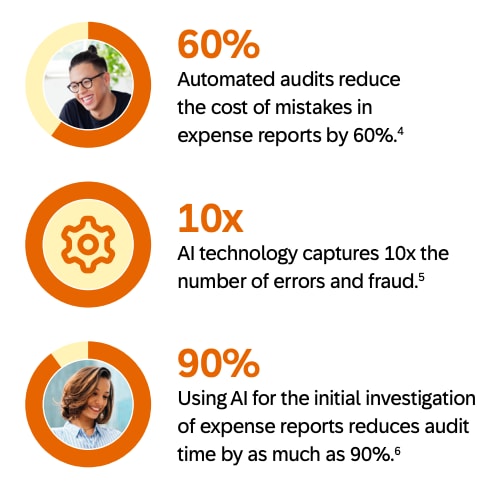Fraud and Compliance
The Hidden Power of Audit Efficiency: 6 Smart Tactics to Take Control of Spend Management
In today's dynamic business climate, finance leaders are under pressure to do more with less. As budgets tighten and compliance standards rise, one thing becomes crystal clear: improving audit efficiency isn’t just a backend process, it’s a strategic advantage.
Whether you’re managing a growing startup, navigating the complexities of a mid-market enterprise, or driving governance at a large corporation, spend visibility and control are essential. But manual processes, disparate systems, and reactive auditing make it tough to keep up.
So what’s the solution? Smarter audit strategies that streamline workflows, minimise risk, and keep your spend policies airtight, without drowning your team in admin.
“By optimising the audit process, companies can uncover hidden inefficiencies, reduce fraud risk, and ultimately protect their bottom line.”

Why Audit Efficiency Should Be On Every CFO’s Radar
Expense audits can feel like a chore. But when done right, they become an engine for better decision-making. An efficient audit process helps identify non-compliant spending, ensures policy adherence, and frees up your finance team to focus on higher-value tasks.
- automated audits reduce the cost of mistakes in expense reports by 60%
- AI technology captures 10x the number of errors and fraud
- Using AI for the initial investigation of expense reports reduces audit time by as much as 90%
"Once we established that we were using Verify and we were going to an AI audit tool, I saw compliance immediately improve. Employees knew that every line item, every expense in every report was going to be reviewed by AI.” Marcy Hagenbuch Finance Systems Specialist, Chobani
Still, many businesses are stuck in reactive mode, manually reviewing expense claims and relying on outdated workflows. That’s where automation, analytics, and strategic policy design come into play.
The right audit tools and techniques can help you:
-
Boost compliance without slowing down employees
-
Catch errors and fraud before they escalate
-
Improve forecasting accuracy and budget control
-
Elevate confidence in financial reporting
“A high-performing audit process does more than just spot errors, it builds trust in your financial data.”
1 Encourage Audit-Friendly Spend Channels
- Promote corporate card use so receipt data flows in automatically
- Pre-load policy rules into card feeds to flag out-of-bounds spend in real time
- Reward card adopters with faster reimbursement to boost uptake
- Provide a one-page “why cards beat cash” cheat sheet for employees
2 Maximise the ROI of Your Audit Process
- Calculate labour cost per audited report and model savings from automation
- Shift low-risk, low-value claims to auto-approval and focus humans on exceptions
- Track cost-per-exception resolved as a pure efficiency metric
- Re-invest saved hours in fraud analytics and vendor negotiations
3 Zero-In on High-Impact Exceptions
- Rank expense types by exception frequency and remediation time
- Rewrite muddy policy rules causing repeated miscoding
- Create targeted training for categories with chronic errors (e.g., mileage, meals)
- Review exception data quarterly and retire rules that add cost without control
4 Boost Your First-Pass Ratio
- Map where reports bounce between submitter, approver and auditor; cut extra loops
- Embed AI receipt checks before manager review to “syphon off” clean reports
- Publish a monthly leaderboard of teams hitting 1:1 first-pass targets
- Tie approver KPIs to on-time, first-time accuracy
5 Put AI on the Front Line
- Use machine learning to review 100% of expenses against policy and tax rules
- Auto-approve low-risk claims; escalate only those flagged for human insight
- Measure hours saved and errors caught to prove the tech’s payback, AI captures 10× more issues and cuts audit time by up to 90%
- Feed resolved outcomes back into the algorithm to sharpen future accuracy
6 Let People Do What Machines Can’t
- Reassign auditors to trend analysis and policy optimisation, not receipt chasing
- Pair each high-risk exception type with a named “human owner” for fast resolution
- Crosstrain finance staff on AI outputs so insight flows to budgeting and forecasting
- Use audit findings to coach spenders and reduce future exceptions at the source
"With Intelligent Audit, we’re inserting audits of policy prior to manager approval. By ensuring policy is followed prior to manager review, we can syphon off more expense reports that don’t require intervention, increasing speed to payment, reducing delinquency, eliminating work from the system, and maintaining our risk profile. When fully deployed, we’ll be able to bypass more than 50% of our expense reports, allowing more time for our leaders to ideate and innovate.” Jeffrey Thompson Director, Payment Services-Program Design, Policy and Sourcing, Merck
Ready to Take a Proactive Approach?
SAP Concur’s latest guide outlines 6 actionable strategies that finance teams can use right now to elevate audit performance and gain greater control over business spend. From leveraging AI to setting smarter audit rules, it’s packed with insights to help you:
- Strengthen internal controls
- Automate low-risk expense reviews
- Empower auditors with the right tools and data
But here’s the catch—the biggest improvements come from small, strategic changes.
Want to find out what they are?
Download the Full Guide
Ready to unlock smarter ways to audit and manage spend?
Download the full report: “6 Ways to Increase Audit Efficiency to Improve Spend Management”
Discover how finance leaders across industries are transforming their audit processes to be faster, more accurate, and aligned with evolving business needs.

